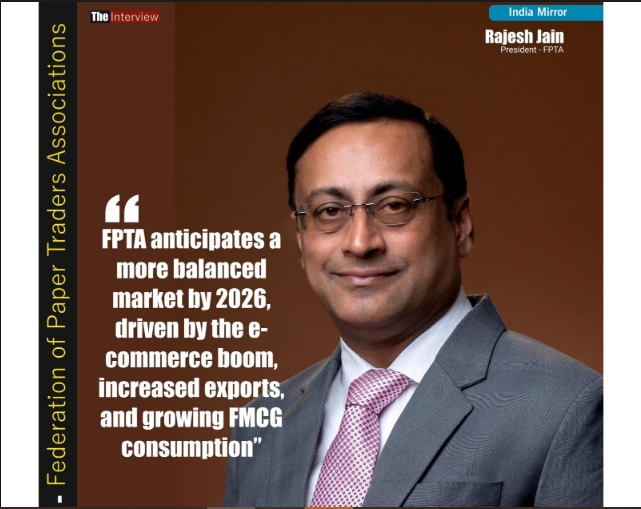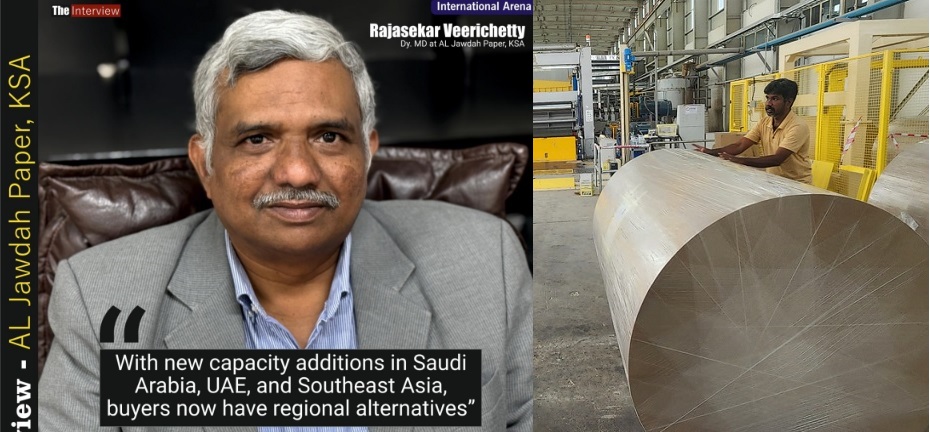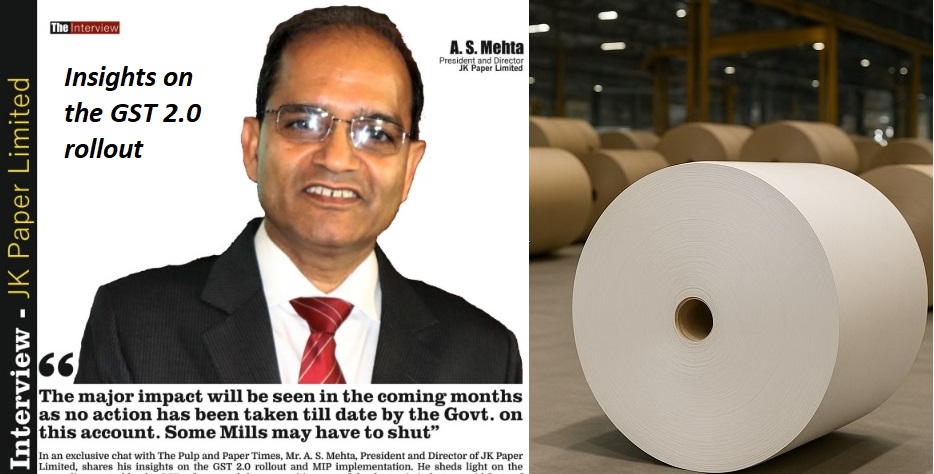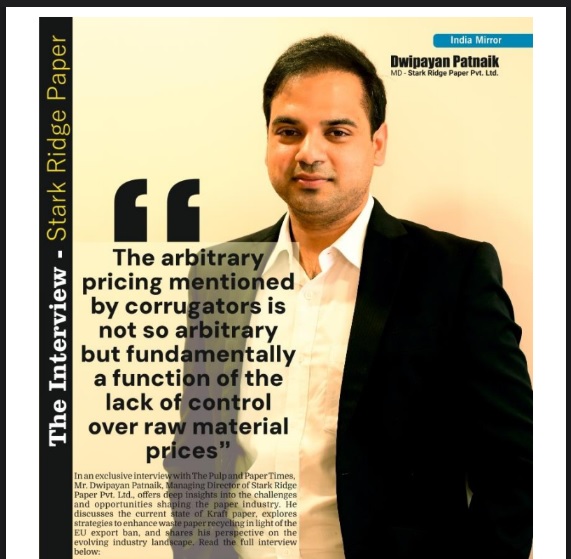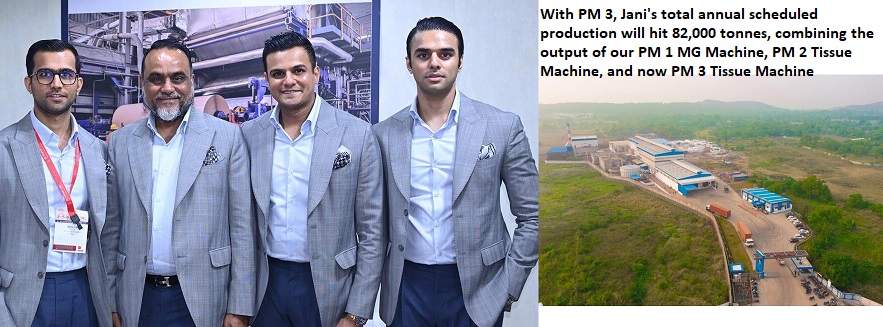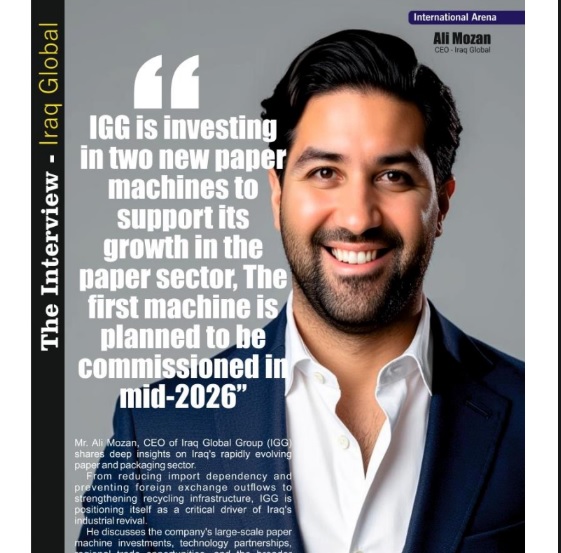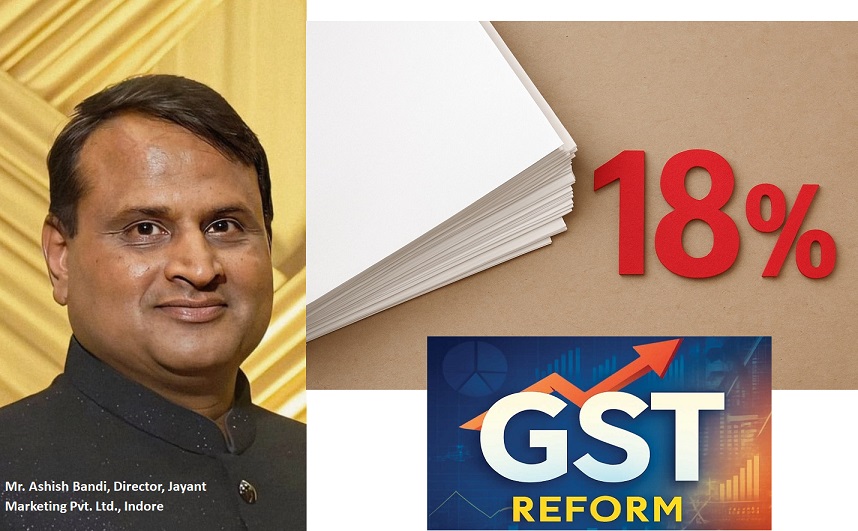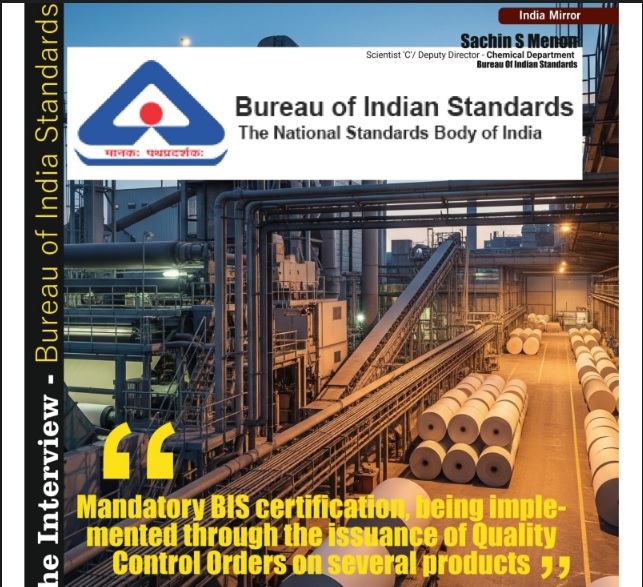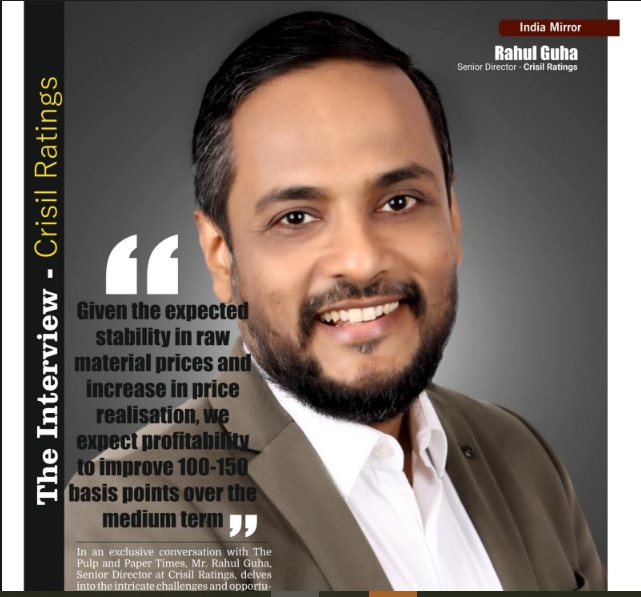Dependence on overseas markets can lead to vulnerabilities, and overcapacity issues can further intensify price competition, Says Cheema Papers' ED
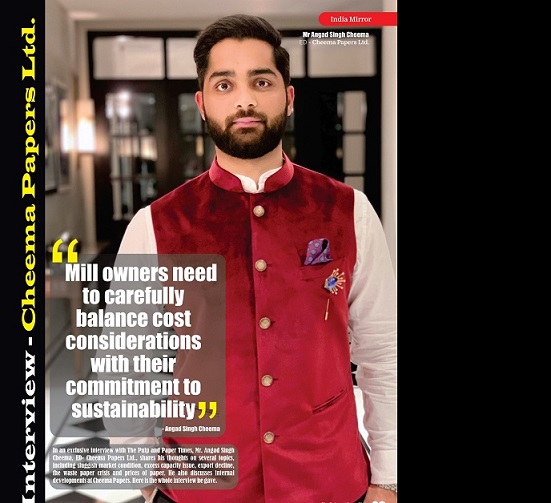
Dependence on overseas markets can lead to vulnerabilities, and overcapacity issues can further intensify price competition, says Cheema Papers' ED
- Optimizing supply chain logistics can reduce costs and enhance the competitiveness of Indian exports
- banding can serve as an impactful and cost-effective means of advertising your products
- A 30-40% excess production in the market indicates a severe oversupply problem. This has lead to falling prices and profit margins for businesses in the industry.
- Several factors influence the dynamics of the global paper industry, and the export landscape can evolve over time
In an exclusive interview with The Pulp and Paper Times, Mr. Angad Singh Cheema, ED- Cheema Papers Ltd., shares his thoughts on several topics, including sluggish market condition, excess capacity issue, export decline, the waste paper crisis and prices of paper. He also discusses internal developments at Cheema Papers. Here is the whole interview he gave.
The Pulp and Paper Times:
Q: Please give us a brief introduction of Cheema Papers Ltd. (CPL)?
Cheema Papers Ltd. is an award winning & leading paper company based out of Uttarakhand, India founded by our Chairman Mr. Harbhajan Singh Cheema and MD Mr. Trilok Singh Cheema that has been producing high-quality paper products for over 3 decades. Our state-of-the-art facilities and experienced team ensure that we consistently deliver top-performing paper products to our customers.
At Cheema Papers Ltd., every single employee is committed to develop the best products using cutting edge technology while focusing on sustainability and environmental responsibility. We aim at using sustainable practices and prioritise reduced wastage and re usability of pulp hence aiming at reducing the carbon foot print.
Our product range includes a variety of paper types, including Duplex board used predominantly in the packaging industry, MG Poster Paper and High BF Kraft used in brown paper bags. Our customer portfolio includes a wide range of reputed multinational corporates and well reputed home grown companies. We take pride in providing customized solutions to meet the unique needs of each customer.
Our company strongly values innovation, sustainability, and customer satisfaction.
Q. Being a reputed paper manufacturer, what is your quick review of the present paper trade market scenario? About demand and supply dynamics of various grades of paper, especially Kraft, Duplex and Tissue paper?
It's evident that the industry is facing significant challenges. Let's break down the key issues:
1. Excess Production: A 30-40% excess production in the market indicates a severe oversupply problem. This has lead to falling prices and profit margins for businesses in the industry.
2. Fluctuating Raw Material Costs: Dependence on international waste paper as a raw material can make production costs unpredictable. Currency exchange rates, trade policies, and geopolitical events are influencing these costs.
3.COVID-19 Impact: The pandemic has disrupted global supply chains and reduced consumer demand. Industries worldwide have been affected, and it's no surprise that the paper mills have been hit as well.
4. Weather-Related Factors: Erratic weather conditions affecting the purchase of consumer goods like refrigerators and air conditioners highlight how external factors can influence demand for packaging products.
5. Increased Competition: The presence of more units, both domestically and internationally, is intensifying competition. This can lead to pricing pressures and a struggle for market share. There are over 800 running paper units in India itself.
It's essential for businesses in this situation to adapt to changing circumstances, remain agile, and carefully monitor market trends to survive and thrive in challenging times.
Q3. Excess Capacity and Export decline have hit hard to Kraft and Duplex paper mills across India. They are operating at lower capacities or taking shutdowns. What factor do you forecast behind this scenario?
There has been an important shift in the market dynamics, especially in the context of packaging materials. Let's delve into this trend and its implications:
1. Reducing Packaging Costs: In the aftermath of COVID-19, many businesses sought to cut costs wherever possible, including packaging. Cost reduction is a common strategy during economic downturns. However, this is often a short-term approach.
2. Environmental Consciousness: There's a growing global awareness of the environmental impact of single-use plastics. Consumers are increasingly concerned about sustainability and are pressuring businesses to adopt eco-friendly packaging solutions.
3. Shift towards paper: Paper is considered a more sustainable alternative to plastic in many applications. It's biodegradable, recyclable, and can be sourced from renewable materials like trees. This shift aligns with broader sustainability goals.
4. Subsidized Rates: Offering high-quality paper packaging at subsidized rates can accelerate the transition away from plastic. Government incentives, industry collaborations, and economies of scale can all contribute to making this shift financially viable for businesses.
5. Regulatory Changes: It's also important to consider that government regulations and policies can play a significant role in encouraging the adoption of eco-friendly packaging. This might include taxes on single-use plastics or incentives for businesses using sustainable materials.
6. Consumer Preferences: As consumer preferences shift toward eco-friendly products and packaging, businesses that proactively adopt sustainable practices may gain a competitive advantage and enhance their brand image.
7. Innovation: The paper industry can further support this trend by investing in research and development to create innovative and cost-effective paper-based packaging solutions that meet the performance requirements of various industries.
While the shift towards sustainable packaging is promising, it's essential to recognize that it may not happen overnight. Mill owners need to carefully balance cost considerations with their commitment to sustainability. Additionally, consumer education and awareness campaigns can help accelerate this transition by highlighting the environmental benefits of paper packaging. In summary, the trend towards paper-based, eco-friendly packaging appears to be a long-term and sustainable shift driven by environmental concerns. Providing high-quality paper at subsidized rates can help facilitate this transition and benefit both businesses and the planet.
Q. How do you see the demand perspective of packaging and corrugated boxes under the sluggish market? Do you think organic packaging growth from the market has vanished due to recession, inflation & high interest rate? New capacities in packaging paper have come in South East Asia, China, and in GCC have really turned down the export of paper from India. Do you think this export decline will remain permanently? Or if not then why?
The decline in paper exports from India, as a result of new capacities in South East Asia, China, and the Gulf Cooperation Council (GCC) countries, may not necessarily be a permanent situation. Several factors influence the dynamics of the global paper industry, and the export landscape can evolve over time. Here are some considerations:
1. Market Cycles: The paper industry, like many others, operates in cycles. Market conditions can change due to various factors, including economic conditions, consumer demand, and industry consolidation. What is currently a decline in exports could shift as market conditions change.
2. Economic Recovery: The global economy goes through periods of growth and recession. When economic conditions improve, demand for various products, including paper, may increase, leading to greater export opportunities.
3. Competition: While new capacities in other regions have intensified competition, they may also create opportunities for collaboration and partnerships. Indian mills can explore joint ventures or alliances to access new markets.
4. Quality and Specialization: Indian paper mills can focus on producing high-quality specialty paper products that cater to specific market niches. These specialized products can find demand even in the face of competition.
5. Environmental Sustainability: If Indian mills adopt environmentally sustainable practices and promote eco-friendly paper products, they may attract customers who prioritize sustainability, opening up new export markets.
6. Trade Policies: Changes in international trade policies and agreements can influence the competitiveness of exports. Advocating for favorable trade agreements can be a strategy to regain market share.
7. Government Support: Collaboration with government agencies can help address trade challenges and promote the export of Indian paper products through supportive policies or incentives.
8. Innovation: Investing in research and development to create innovative paper products can differentiate Indian mills in the global market.
9. Supply Chain Optimization: Optimizing supply chain logistics can reduce costs and enhance the competitiveness of Indian exports.
It's important to note that while the current export decline may not be permanent, the industry may continue to face evolving challenges. Companies that remain adaptable, stay at tuned to market trends, and actively seek opportunities for growth and collaboration are more likely to navigate these challenges successfully and regain their competitive edge in the global paper market.
Q. Please shed some light on CPL new developments. Is CPL planning to expand in any other segment?
In keeping with the modernization effect and market requirements, CPL since the last two years has brought in some major development in the unit. Right from modernizing our pulp mill, to revamping our coating plant, finishing house and improving our quality we are catering to the current market requirements. On our MG Yankee machine, we have changed our pulp line making it to cater to the new segment of Kraft packaging bags. In future, as and when the market stabilizes we have plans of expanding further.
Q. Recently, few paper mills in Vapi and Morbi shut in last six months. How do see this development for the paper industry? Should we accept this as a consolidation face?
The challenges faced by mills located near the coast, especially those oriented toward catering to overseas markets, are indicative of the wider impacts that the COVID-19 pandemic and other global economic factors have had on various industries. Let's delve deeper into these challenges:
1. Export Dependence: Mills located near the coast often have a strategic advantage in terms of logistics and transportation for international trade. However, during periods of sluggish exports, such as those seen post-COVID-19, this dependence on overseas markets can lead to vulnerabilities.
2. Price Wars: Intense competition and price wars can erode profit margins and create an unsustainable environment for businesses. To stay competitive, mills may lower prices, but this can negatively affect their long-term financial stability.
3. Excess Supply: A surplus of production in the market can lead to overcapacity issues, which, in turn, can further intensify price competition. It's challenging for individual mills to manage excess supply on their own.
4. Survival Strategies: In times of market turmoil, survival strategies may include cost-cutting, efficiency improvements, diversification of product offerings, and seeking new domestic or international markets to reduce reliance on a single region.
5. Government Support: Collaboration with government agencies and industry associations can be crucial for addressing challenges like these. Governments may provide support through policies that promote exports, stabilize prices, or encourage sustainable practices.
6. Economic Recovery: The global economy can be cyclical, with periods of slowdown followed by recovery. It's important for mills to plan for both challenging and prosperous times. Being prepared to scale up production when demand returns can be a strategic move.
7. Sustainability and Innovation: Investing in sustainability practices and innovative product development can differentiate mills in the market and attract customers who prioritize eco-friendly and unique products.
8. Risk Management: Mill operators should conduct thorough risk assessments and consider diversifying their customer base. This can help spread the risk associated with overreliance on a single market.
While these challenges are significant, it's important to remember that industries can adapt and recover. Staying agile, focusing on quality, and finding ways to add value to your products can help mills not only survive but thrive in the long term, even in competitive and challenging markets.
Q. In the current situation, every paper mill in Kraft segment is facing many critical operational and marketing issues such as lack of sufficient orders in hand, uncertainty of orders and compromise in finished paper prices. Can paper mills in particular regions collectively develop a mutual consent or schedule/allot their paper machines (PM) product-wise under ‘ONE Machine, ONE Paper grade in ONE region’ planning? So that paper mills can run the plant on 100% capacity without having impact from external demand factors.
While adopting a standardized approach across multiple mills can be challenging due to differences in setup, leveraging your mill's unique strengths and capabilities can be a strategic advantage. Adaptability, market intelligence, and a customer-centric approach are key to navigating the complexities of the paper industry effectively. When products and processes vary significantly across different paper mills, adopting a standardized "One Machine, One Paper Grade in One Region" approach may not be feasible. In such cases, it's important to focus on strategies that optimize the unique strengths and capabilities of each mill.
Q. In 2018, the Central Pollution Control Board of India conducted a life cycle analysis of some commonly used packaging materials and found that a paper bag has 2-3 times more global warming potential as compared to a plastic bag. The processing phase of virgin as well as recycled paper is highly water and energy-intensive; it includes adding various chemicals like bleaching agents which have ozone-depleting potential. As a paper manufacturer, how would you counter this claim?
If we don’t recycle, the world will become a dump yard. Here are some key points :
1. Recycling: Manufacturing paper from 100% waste paper is a significant contribution to reducing the demand for new raw materials and conserving natural resources. It also helps in diverting waste from landfills.
2. Water Recycling: Utilizing recycled backwater in your processes is an excellent example of water conservation. It minimizes the use of freshwater resources and helps in maintaining the ecological balance of water ecosystems.
3. Plastic Reduction: Recognizing the harmful effects of single-use plastic and actively seeking alternatives is crucial for environmental conservation. Reducing plastic use helps protect terrestrial and marine ecosystems.
4. Renewable Energy: Transitioning to renewable energy sources like solar power is an important step in reducing the carbon footprint of your operations. It contributes to cleaner energy production and lower greenhouse gas emissions.
5. Environmental Awareness: Your awareness of the environmental consequences of various practices is essential. Educating employees, customers, and stakeholders about sustainability can have a ripple effect in promoting eco-friendly practices.
6. Corporate Responsibility: By implementing sustainable practices, your company demonstrates corporate social responsibility. This can enhance your brand's reputation and attract environmentally conscious customers.
7. Regulatory Compliance: Staying in compliance with environmental regulations and standards is not only legally required but also vital for responsible business practices.
8. Continuous Improvement: It's important to continue seeking ways to further reduce your environmental impact. Regularly assessing and updating sustainability practices to stay aligned with evolving environmental goals and regulations will definitely bring in a change.
Q: Do you believe 'Banding of a paper product' is a requirement or a financial burden?
Banding of paper products for advertisement can be either a valuable marketing tool or a financial burden, depending on your specific circumstances and goals. It's important to conduct a cost-benefit analysis, consider the preferences of your target audience, and align your banding strategy with your overall marketing and sustainability objectives. When done effectively, banding can serve as an impactful and cost-effective means of advertising your products.
Q: Any message you want to convey to the Paper industry
”Hang On” were all it in together. This is the time for us to stay strong together as an association. We sure will come out of it.
Web Title: Dependence on overseas markets can lead to vulnerabilities, overcapacity issues can further intensify price competition, Says Cheema Papers' ED




 Join WhatsApp Group
Join WhatsApp Group Join Telegram Channel
Join Telegram Channel Join YouTube Channel
Join YouTube Channel Join Job Channel (View | Submit Jobs)
Join Job Channel (View | Submit Jobs) Join Buy Sell Channel (Free to Submit)
Join Buy Sell Channel (Free to Submit) Paper News Headlines Channel (Free to read)
Paper News Headlines Channel (Free to read)




